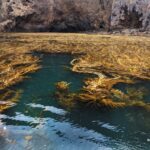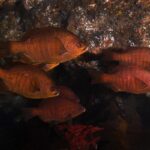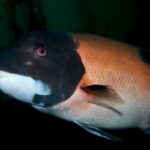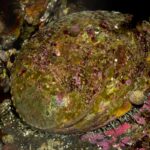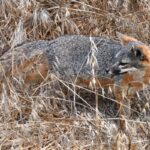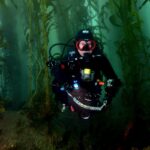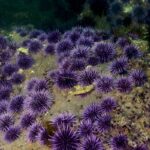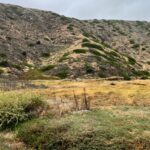There’s a jungle off the California coast.
It is lush, and green, and filled with a marvelous diversity of life. It is every bit a wilderness, with a complex eco-system that is both resilient and fragile. And if you were to look at the islands poking their heads above the water about an hour outside of Ventura, you’d be surprised to be using those words.
Words & Photos by Michael Salvarezza & Christopher P. Weaver
The islands look barren and dry. Hardly the place for thick jungles of plants and trees. But beneath the waves off these coasts lie the magnificent kelp forests, dense groves of mesmerizing plants swaying with the movement of the water and harboring some of the most beguiling temperate marine life to be found anywhere.
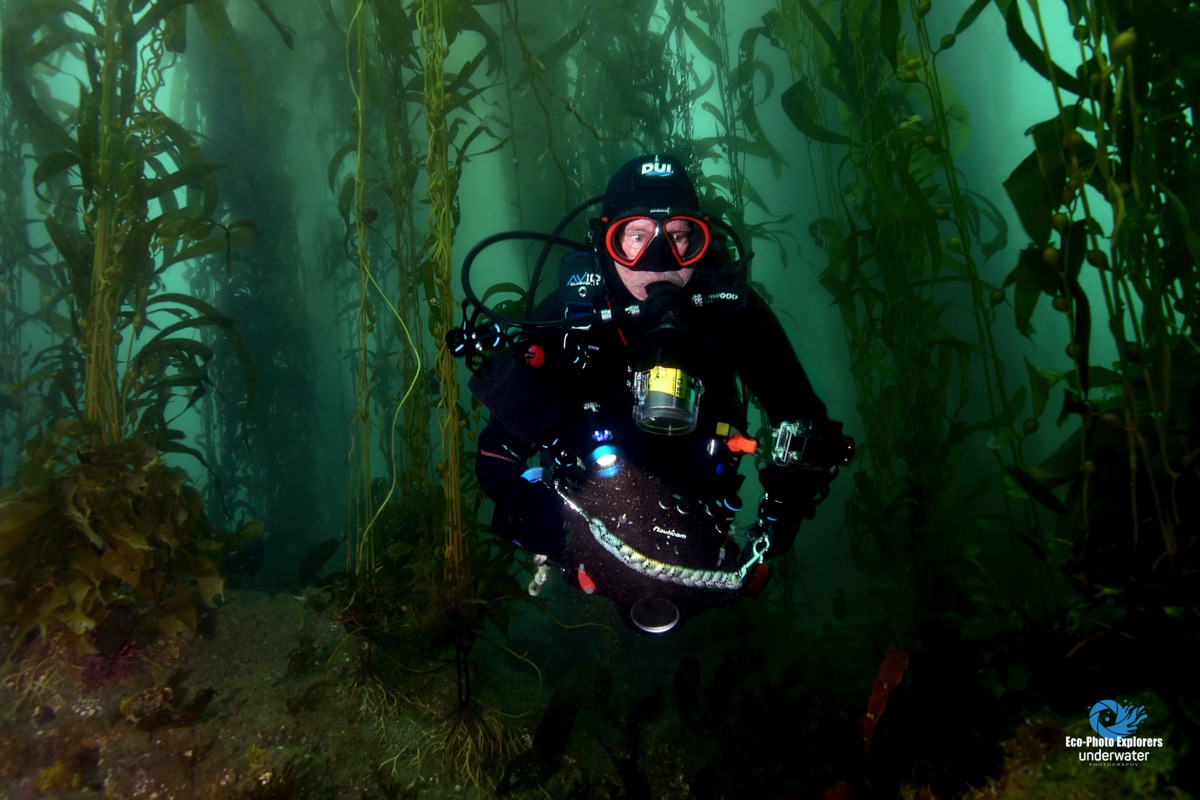
Author Christopher Weaver explores the kelp
Let’s explore the kelp forests of California’s Channel Islands.
The Channel Islands were created through tectonic forces about five million years ago. Today, there are two groups of islands: the Santa Barbara group is to the north and consists of San Miguel Island, Santa Rosa Island, Santa Cruz Island and Anacapa. To the south is the Santa Catalina group, which includes Santa Barbara, San Nicholas, San Clemente and Santa Catalina.
Our expedition was to the northern group of islands, accessible from Ventura, about an hour and half drive from Los Angeles. With San Miguel currently administered by the US Navy, and Santa Rosa privately owned and leased for game hunting, we focused on Santa Cruz and Anacapa for our underwater exploration.
The islands are routinely visited by dive boats, and tour boats leading land excursions, but don’t let that fool you…despite the relative ease of access, these are indeed unique marine ecosystems and genuine wilderness areas.
We set out on our first dive day from the harbor at Ventura to the three islets collectively referred to as Anacapa. The days here all seem to start with the grey overcast of the marine layer that moves in off the Pacific Ocean. The trip to Anacapa crosses the Santa Barbara Channel, one of the richest marine habitats anywhere. With depths reaching 6,000 feet, and with capricious conditions, the crossing can range from flat calm, to bumpy, to too rough to dive. We were fortunate to only experience mild swells.
Along the way, Brown Pelicans, California Sea Lions, and pods of Dolphin are commonly seen. Less frequently encountered are Blue Whales, Humpback Whales and Fin Whales. Keep your eyes focused on the water to catch a glimpse of the marine potpourri as you traverse this region.
Before long, the rugged outline of Anacapa appeared out of the haze and in short order we were moored below the Anacapa Lighthouse. It was time to dive.

Kelp forests provide endless dive opportunities
The dive site was called Cathedral, and here we found a lush grove of Kelp rising from the rocks in only about 30 feet of water. For divers who have never experienced Kelp, the seaweed attaches itself to rocky substrates through a system of fronds called “holdfasts” and then rises vertically to the surface, growing at the prodigious rate of up to 2 feet a day. These vertical “trees” extending over a wide swath of ocean floor create the illusion of diving through the trees of a forest. It can be an intimidating experience at first but as the initial discomfort fades, these dives can become magical.
By the time we surfaced, the marine layer had retreated and blue sky and sunshine was kissing the top of Anacapa Island.
A short distance away was our second dive site, known as Channel. Here, another thick jungle of kelp harbored a plethora of marine life. Focusing on the small world of macro, we observed the brilliantly colored Spanish Shawl nudibranch, often in pairs, crawling along the bottom unconcerned about the six-foot bubble blowing giants that were photographing them. We also could not resist making images of the Rockpool Blenny, small 2-inch bottom dwellers that seemed abundant and unafraid. Anemones, tube worms and myriad small creatures kept our cameras and memory cards humming.
Our third dive of the day was at Archway. Here, a massive underwater arch forms a swim through for adventurous divers. Approaching the arch from the open ocean side, the passage leads to a lush stand of kelp. At the exit of the arch, we spent time with one of California’s iconic Garibaldi, who was vigorously defending her mat of eggs.

Garibaldi are the California State Fish
The water temperatures here were in the mid-60s in mid-July, with visibility lower than expected and topping out at about 20 feet. Recent swells had stirred the bottom and cut the clarity down. Still, the kelp forests maintain a stately appearance with the rays of sunlight streaming through the kelp fronds and dancing among the kelp stalks.
Indeed, with the canopy of kelp above cutting the sunlight, we peered into the forest of seaweed and wondered what mysteries could be found in the bowels of the underwater jungle.
Divers always run the risk of entanglement in the kelp. At depth, the number one safety rule is to not panic if you find yourself gripped by the kelp. Twisting and turning in a frantic effort to get out of the kelp will only make it worse. The best course of action is to stop, relax and slowly back out the way you came. If that doesn’t work, snapping the stalks like a twig rather than pulling on them will often release the grip. A small pair of scissors or a sharp knife can also come in handy. And most effective is a buddy who can remove the kelp fronds easily.
Sometimes divers find themselves on the surface amongst thick mats of kelp fronds, This can be a tricky situation to navigate, especially if a surface swim to the boat is necessary. Here, the best technique is to descend and swim beneath the kelp if possible. Otherwise, using your arms to push the kelp in front of you down as you slowly crawl on the top of these kelp plants will often work.
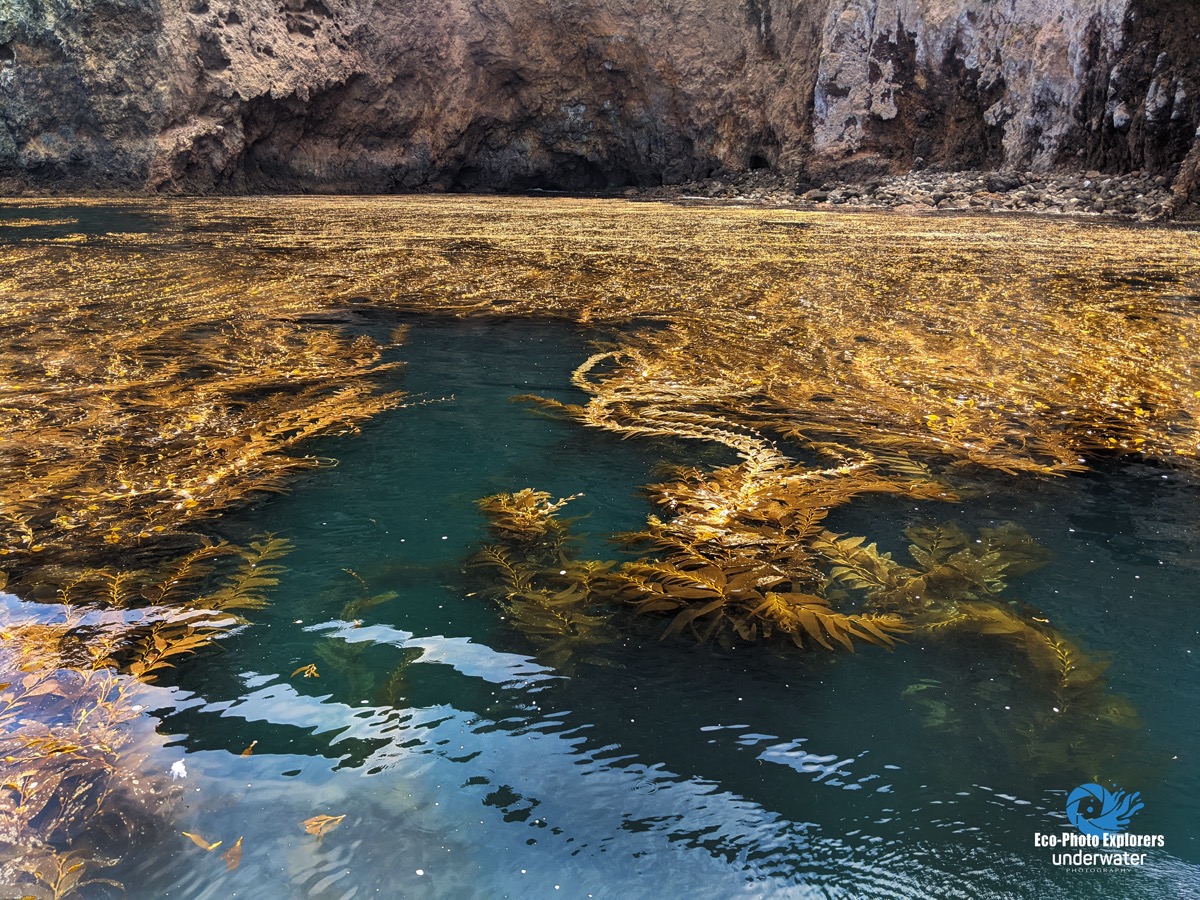
Kelp grows at a prodigious rate
On our second day of diving, we returned to Anacapa to dive Sea Lion Cave, Goldfish Bowl and Twin Bay Point. On these dives, we found additional species of nudibranchs, more blennies and some interesting kelp dwellers, like the Kelpfish and Kelp Greenlings. Goldfish Bowl offered a beautiful underwater topography, with a tumbling rocky wall and featuring a very healthy stand of kelp in a curving bay. We found some of the best photographic opportunities to be at the edge of the rocks and the sand, where the kelp forests begin to grow.
As our fins stirred the bottom sand, a pair of large California Sheephead began following us, looking for a quick and easy meal. Joining them were Calico Bass and Rock Wrasse, similarly searching for a quick bite in the detritus kicked up by our movements.
It was time to explore Santa Cruz. The Channel Islands are part of the National Park System and there is a National park Service visitor center in Ventura Harbor. Also, the waters around the islands are largely, although not entirely, protected as a marine Protected Area. After a day spent hiking on the island and learning about its fascinating history, along with the efforts of the National Park Service and the Nature Conservancy to restore the island to its natural state, we wanted to see the underwater side of Santa Cruz.
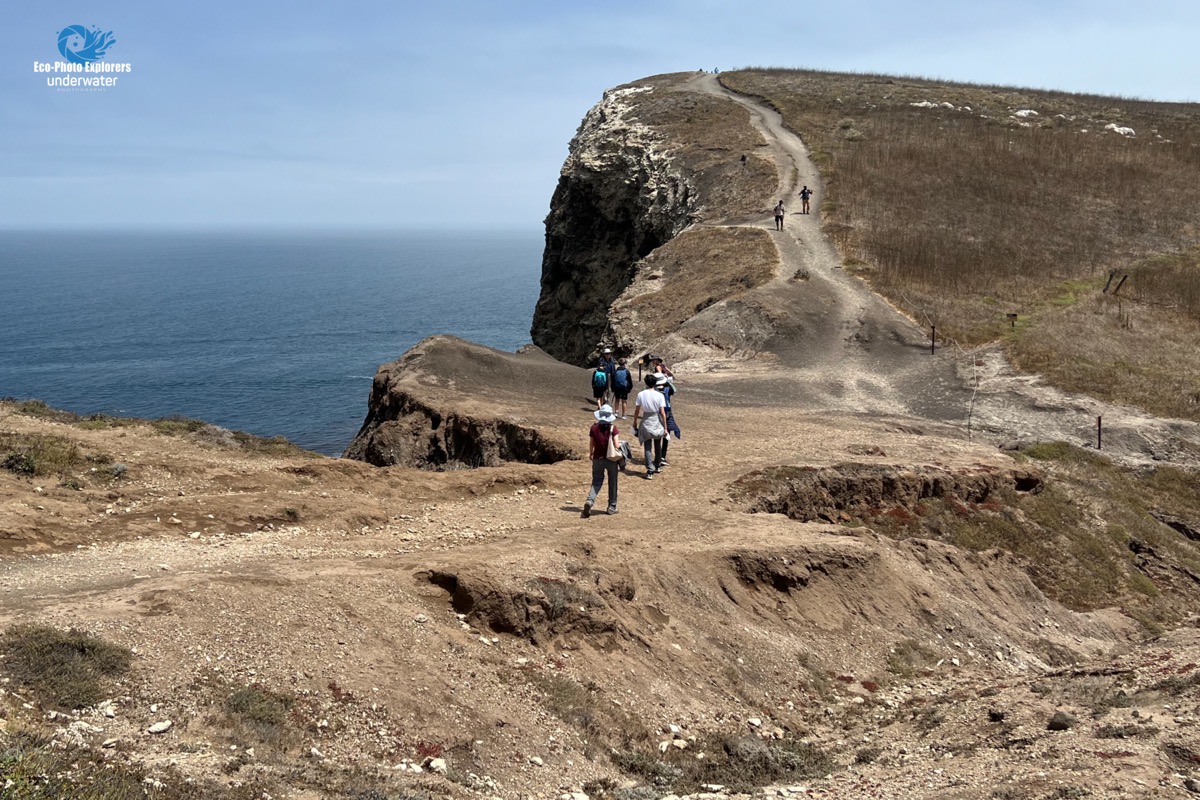
Hiking on Santa Cruz Island
Hungry Man Gulch was where we moored for our dive on Santa Cruz. Here, we came face to face with the stark realities of these fragile environments. With rocks and boulders strewn across the bottom, kelp should have been growing prodigiously. Instead, we found armies of purple sea urchins covering the rocks everywhere we looked.
Sea urchins do not normally threaten a healthy kelp forest. Their populations are kept in check by sea otters and other predators. But when food is scarce, and when predators like the Sea Otters have been removed from the ecosystem, the normally isolated sea urchins band together and begin to forage as a collective unit. This is a form of “hive mentality” and it can have serious consequences on kelp. This situation is made worse if the kelp itself is not healthy. With warmer waters due to climate change stressing the kelp, the sea urchin armies end up consuming all of the kelp, leaving a barren wasteland where a once-healthy kelp forest may have thrived.
Our images of rocks covered with sea urchins are arresting and heart breaking and are stark examples of nature that is out of balance.
We left Santa Cruz and returned to the healthier kelp of Anacapa to round out our last dives. Before we ended our expedition, we spotted several Angel Sharks, small bottom dwelling sharks that love to bury themselves in the sand to ambush prey and avoid detection.
To the keen eye, the kelp forest presents ecosystems of different flora and fauna at different depths. On the sea floor, we find the bottom dwellers like the Angel Sharks and other marine invertebrates. Octopus can sometimes be found hiding in the rocks, along with Spiny Lobster and multitudes of different colored starfish. Red Coralline Algae, sea fans, tunicates and even large abalone round out the list of organisms to be found here.

A Green Anemone in the sand
As we ascend through the kelp in mid-water, we find different species of fish. Most of these are adapted to blend in with the kelp and are often golden yellow or orange colored. Senorita fish, kelp fish, perch and the occasional Giant Sea Bass can be found here.
In the canopy, yet a different ecosystem of marine life can be found, including the Norris Top Snail and the barnacles that attach themselves to the snail’s shell.
Diving the kelp forests of California’s Channel Islands is a rewarding experience for divers of all skill levels. The rich marine world that surrounds these islands can be fascinating and captivating, and many divers return again and again to spend time in these underwater jungles. Our visit was far too short and as our time drew to a close on our final dive we began to feel the desire to linger a bit longer.
Our final farewell came from a robust harbor seal that swam quickly through the dense foliage of kelp to take a quick look at us before jetting off into the dark confines of the kelp jungle. We had been hoping for a visit from these inquisitive pinnipeds and, of course, when it finally happened we had our macro lenses on the cameras so we couldn’t get a photograph of our seal sentry…we’ll just have to return and try again!
- Kelp fronds create interesting image possibilities
- Kelp forests provide endless dive opportunities
- Kelp grows at a prodigious rate
- California Sea Lions have found an interesting spot to haul out
- A stand of Kelp near Anacapa Island
- A school of Black Perch off the shores of Anacapa
- A Green Anemone in the sand
- A tangle of Kelp reaching towards the surface
- California Sheephead are common Kelp denizens
- Santa Cruz’s rugged shoreline
- Abalone were once plentiful in these waters
- A Channel Islands Fox on Santa Cruz Island
- Garibaldi are the California State Fish
- Kelp Forests make for magical dives
- Kelp Bass often follow divers into the kelp
- Author Christopher Weaver explores the kelp
- Look on the rocks and you might find Spanish Shawl nudibranchs
- An Angel Shark resting on the bottom
- Purple Sea Urchins can decimate kelp forests
- The islands are being restored to their native state
- Hiking on Santa Cruz Island



